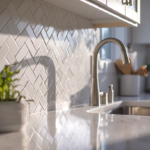Installing a solar panel system is a crucial step towards sustainable energy consumption. This article will guide you through the process, providing professional insights on selecting the right solar panels, assessing your energy needs, sizing and designing the system, mounting and installing the panels, wiring and connecting them, and monitoring and maintaining the entire system. By following these steps, you can confidently install a solar panel system that meets your energy requirements and contributes to a greener future.
Selecting the Right Solar Panels
When selecting the right solar panels, it is crucial to consider their efficiency and durability to ensure optimal performance and longevity. Solar panel efficiency refers to the ability of the panels to convert sunlight into electricity. Higher efficiency panels can generate more electricity from the same amount of sunlight, making them more cost-effective in the long run. It is advisable to choose panels with a higher efficiency rating to maximize the energy output. Additionally, considering the solar panel warranty is essential. A good warranty ensures that any potential defects or issues with the panels will be covered by the manufacturer. It is recommended to select panels with a longer warranty period, as this reflects the manufacturer’s confidence in the product’s quality and durability.
Assessing Your Energy Needs
To accurately determine the appropriate size and capacity of your solar panel system, it is important to assess your energy needs in terms of daily electricity consumption and future growth potential. This assessment will help you determine the number of solar panels and their efficiency required to meet your energy demands. Solar panel efficiency refers to how well a panel converts sunlight into usable electricity. Higher efficiency panels will generate more electricity and require fewer panels to meet your energy needs. Additionally, it is important to consider financing options when installing a solar panel system. Many companies offer financing plans that allow you to pay for your system over time, making solar power more accessible and affordable. By carefully assessing your energy needs and exploring financing options, you can make an informed decision about installing a solar panel system.
Sizing and Designing Your System
Determining the appropriate number of solar panels and their placement is crucial when sizing and designing your solar panel system for optimal energy production. Several designing considerations need to be taken into account to ensure that the system meets your energy needs efficiently. One of the key factors to consider is solar panel efficiency. The efficiency of a solar panel refers to the amount of sunlight it can convert into usable electricity. High-efficiency solar panels can generate more electricity using the same amount of sunlight compared to lower efficiency panels. This means that fewer high-efficiency panels may be required to meet your energy needs, reducing the overall cost and space requirements of the system. Additionally, the orientation and tilt angle of the panels should be optimized to maximize solar exposure. Properly sizing and designing your solar panel system will ensure maximum energy production and long-term benefits.
Mounting and Installing Solar Panels
When it comes to mounting and installing solar panels, there are several factors to consider. Firstly, you will need to decide whether you want to install the panels on your roof or on the ground. Secondly, you will need the necessary tools and equipment to safely and securely mount the panels. Finally, you will need to understand the wiring and connections involved in connecting the panels to your electrical system.
Roof or Ground
The optimal solution for placing solar panels is by carefully considering the pros and cons of mounting them on the roof or installing them on the ground. Roof installation offers several advantages. Firstly, it maximizes the use of available space, especially for homeowners with limited yard space. Additionally, roof-mounted panels are less prone to damage from vandalism or accidental collisions. They also benefit from increased exposure to sunlight, resulting in higher energy production. However, roof installation can be more expensive due to the need for specialized mounting equipment and potential structural modifications. On the other hand, ground installation provides flexibility in panel orientation and tilt, optimizing energy production. It is also easier to maintain and clean the panels. Nevertheless, ground installation requires a larger land area, which may not be feasible for all homeowners. Ultimately, the choice between roof and ground installation depends on individual circumstances and preferences.
Tools and Equipment
While considering the most efficient method for installing solar panels, it is important to discuss the necessary tools and equipment required for proper mounting. The tools selection process is crucial in ensuring a smooth installation process and achieving optimal results. A variety of tools are necessary for solar panel installation, including but not limited to: a drill, a wrench, a screwdriver, wire cutters, and a multimeter. These tools are essential for tasks such as drilling holes for mounting brackets, tightening bolts and screws, cutting and stripping wires, and testing the electrical connections. Additionally, equipment installation involves the use of specialized equipment like mounting brackets, rails, and clamps, which provide stability and secure the solar panels to the roof or ground. Careful consideration should be given to the quality and durability of the tools and equipment selected, as they play a crucial role in the long-term performance and reliability of the solar panel system.
Wiring and Connections
An efficient and reliable solar panel system installation requires proper wiring and connections to ensure the seamless flow of electricity. When installing a solar panel system, it is important to follow safety precautions to minimize the risk of electrical accidents. Firstly, ensure that the system is properly grounded to prevent electrical shocks. Use insulated tools and wear appropriate protective gear to further enhance safety. Additionally, it is crucial to carefully plan the wiring layout and use appropriate wire sizes to handle the current flow. Regular inspections and maintenance are necessary to identify and rectify any loose or damaged connections. Troubleshooting tips include checking for loose connections, damaged wires, and ensuring proper polarity. By adhering to these safety precautions and troubleshooting tips, the solar panel system will operate efficiently and reliably while minimizing the risk of electrical hazards.
Wiring and Connecting Your Solar Panels
Each solar panel installation requires careful consideration of the wiring and connecting process to ensure optimal performance and efficiency. When installing solar panels, it is crucial to properly connect the solar cells to form a complete circuit. This involves making electrical connections between the individual solar cells to create a series or parallel configuration, depending on the desired voltage and current output. The wiring and connecting process should be done with great attention to detail to minimize power losses and maximize energy production. It is important to use high-quality connectors and cables that can withstand the outdoor elements and ensure a secure and reliable connection. Additionally, proper grounding of the solar panel system is essential to protect against electrical faults and ensure the safety of the installation. Overall, the wiring and connecting of solar panels play a crucial role in the overall performance and efficiency of a solar panel system.
Monitoring and Maintaining Your Solar Panel System
Regularly monitoring and maintaining your solar panel system is essential for ensuring its optimal performance and longevity. With advancements in monitoring technology, it has become easier than ever to track the performance of your solar panel system. By using monitoring technology, you can keep a close eye on the energy production of your panels and identify any issues or inefficiencies. This allows you to address problems promptly and ensure that your system is operating at its full potential. In addition to monitoring, regular maintenance is also crucial for the longevity of your solar panel system. This includes cleaning the panels to remove dirt and debris, inspecting for any damage or wear, and checking the connections and wiring. By staying vigilant with monitoring and maintenance, you can maximize the benefits of your solar panel system and prolong its lifespan.




